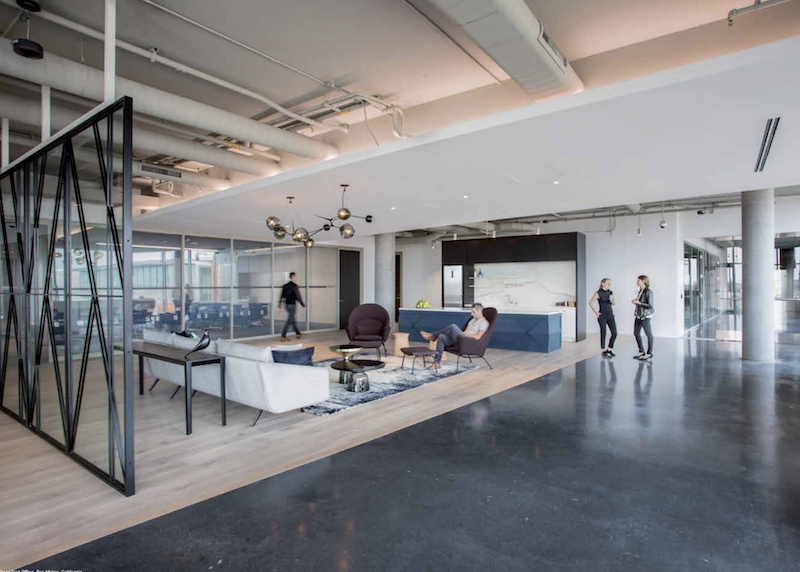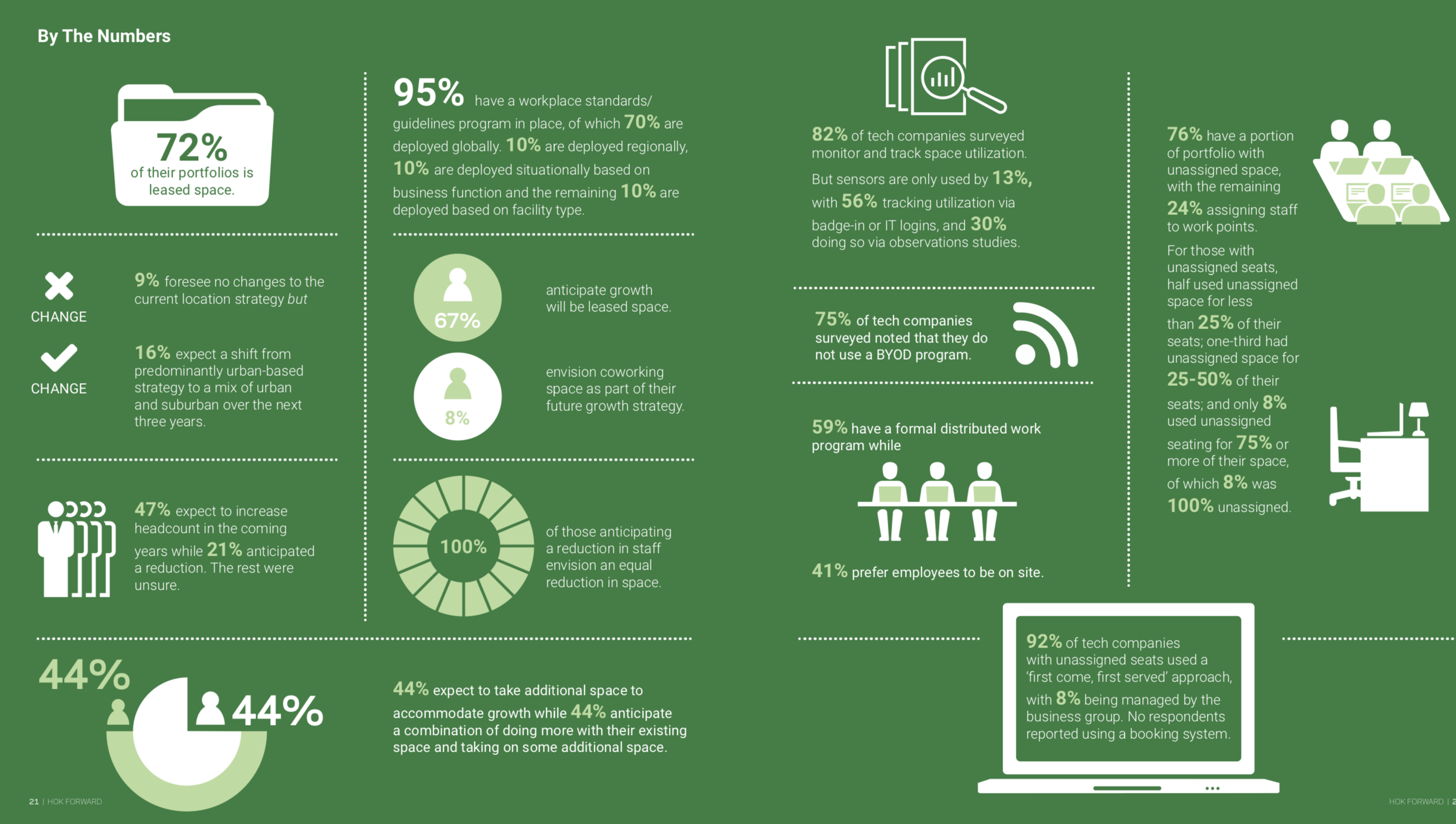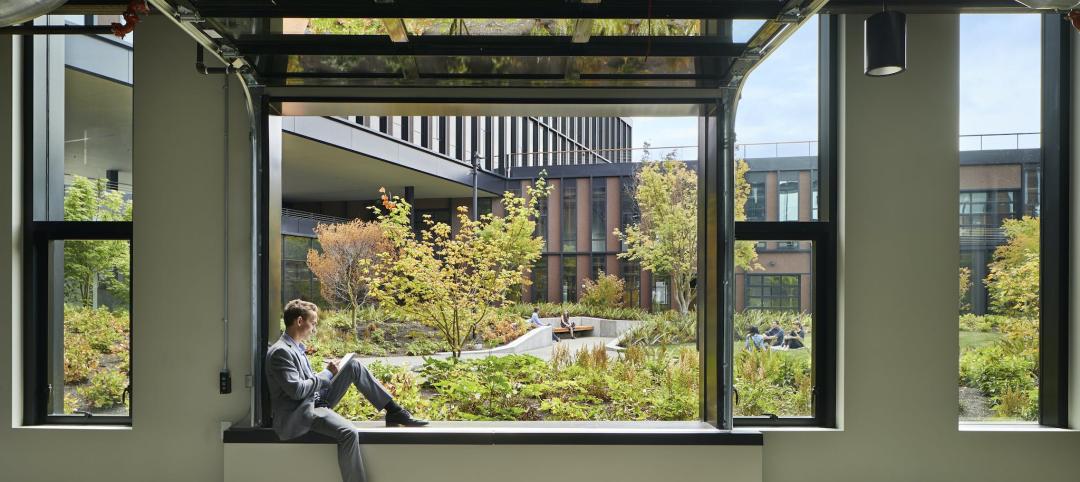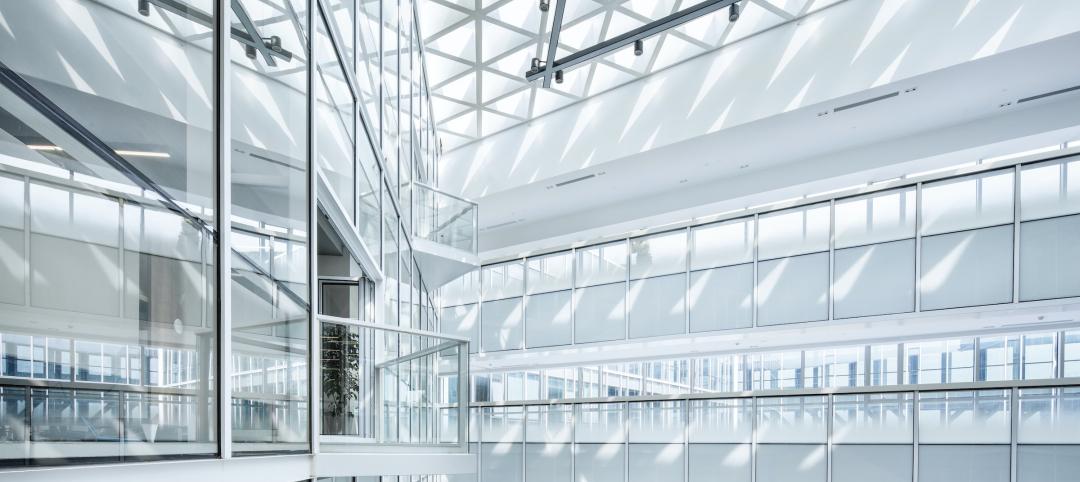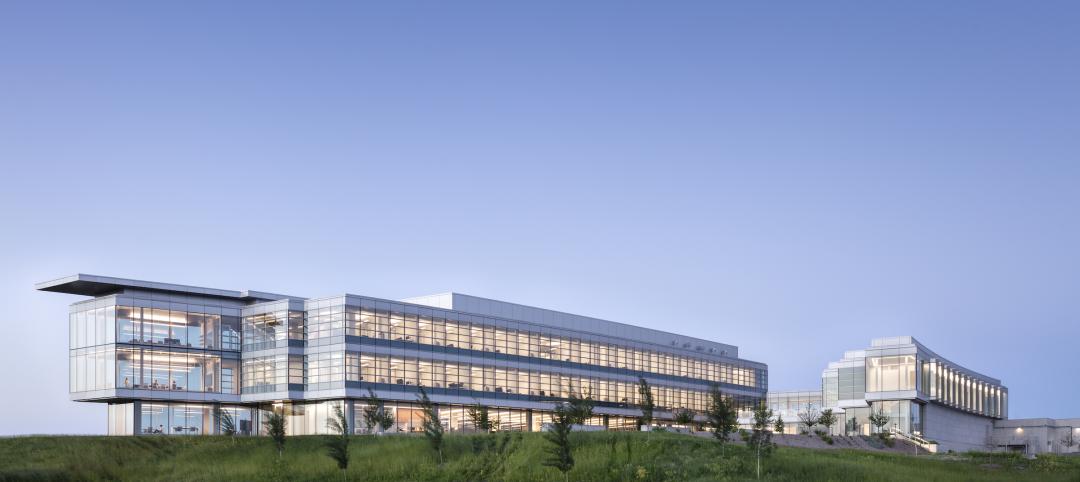How are leading tech firm responding to their workplace challenges? That’s a question that HOK, the global design firm, examines in “HOK Forward: Tech Workplace Takes Center Stage,” an 83-page report based on input from the firm’s Workplace leadership and global delivery network partners.
As part of its research to identify best practices, HOK’s team interviewed a who’s who of end-user tech companies, including Cisco Systems, Google, IBM, Microsoft, Nokia, Spotify USA, and T-Mobile.
One of the report’s observations is that tech is now all-pervasive in the workplace. “We are quickly evolving toward an era in which tech is not just a discrete sector but a foundational element of all businesses,” the report states. ”More and more companies are considering themselves ‘tech’ companies regardless of the sector they are in.”
The report notes that as tech companies expand into traditional industries, they often have a competitive advantage because they fall outside the purview of state and federal regulations. However, that regulatory climate is changing, as options for nascent technologies are defined and sometimes restricted, and bigness is no longer seen as an unassailable virtue.
The HOK report, based on input from the firm's Workplace leadership and global delivery partners, portrays a tech industry that is weighing all kinds of factors that might enhance the user experience. (Click for larger image) Image: HOK Forward report
There is also the question of whether technology is, inadvertently, accelerating the expected obsolescence of businesses. Globally, the average life expectancy of a company is less than 20 years. Up to 80% of today’s businesses may not exist in 10 years, states the report.
On top of—or, perhaps, because of—that churn, nearly half of all global employers are struggling to fill positions. Consequently, Tech employers are enticing professionals to join their organizations from other sectors. “To ensure that their people remain valuable, productive and engaged, tech employers must adopt retraining and redeployment strategies,” the report states.
In this high growth sector, HOK’s survey portrays an industry whose companies tend to lease in urban environments. These companies continue to increase their headcounts, but envision accommodating more people within their existing footprint before deciding to expand. More than two-fifths (43%) of companies polled prefer to have employees on-site, and are designing their environments to encourage synergy, ideation, and speed to market.
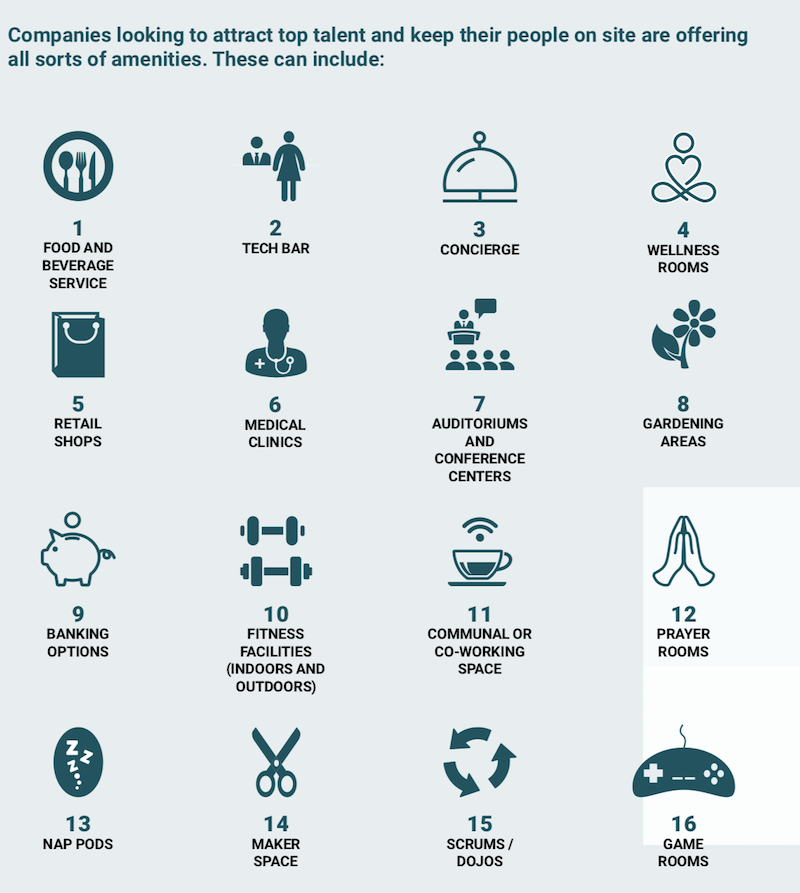
The right mix of amenities is critical to creating a workplace that foments innovation and productivity. Image: HOK Forward report
The cost of real estate—the cost per sf for tech office space ranges from $80 to $300, and averages around $190—and time spent at the office continue to be the most important factors influencing workspace allocation. These companies’ top priorities include enhancing the employee experience and creating flexible spaces.
While tech companies insist that they value sustainable design, 87% said they wouldn’t seek formal LEED certification for their workplaces, and—here’s a stunner—92% did not intend to seek formal WELL certification for workplace wellness.
That being said, amenities are evolving: Companies looking to attract and retain top talent now offer everything from nap pods and wellness rooms to medical clinics and maker spaces.
“Smart“ workspaces, tracked by networks of sensors, are increasing, too, as designers and clients continue to learn how to leverage data in order to optimize and right-size space that reflects the company’s culture, work style, mobility profiles, and business goals.
The report provides a wealth of case studies that illustrate many of its findings. It also offers readers a list of “priority actions” that revolve around flexibility, employment empowerment, training, and “leveraging the contingent workforce.”
The report predicts that the next generation of high-performance tech workplaces will function as engagement centers and dynamic hubs where people gather, connect and innovate.
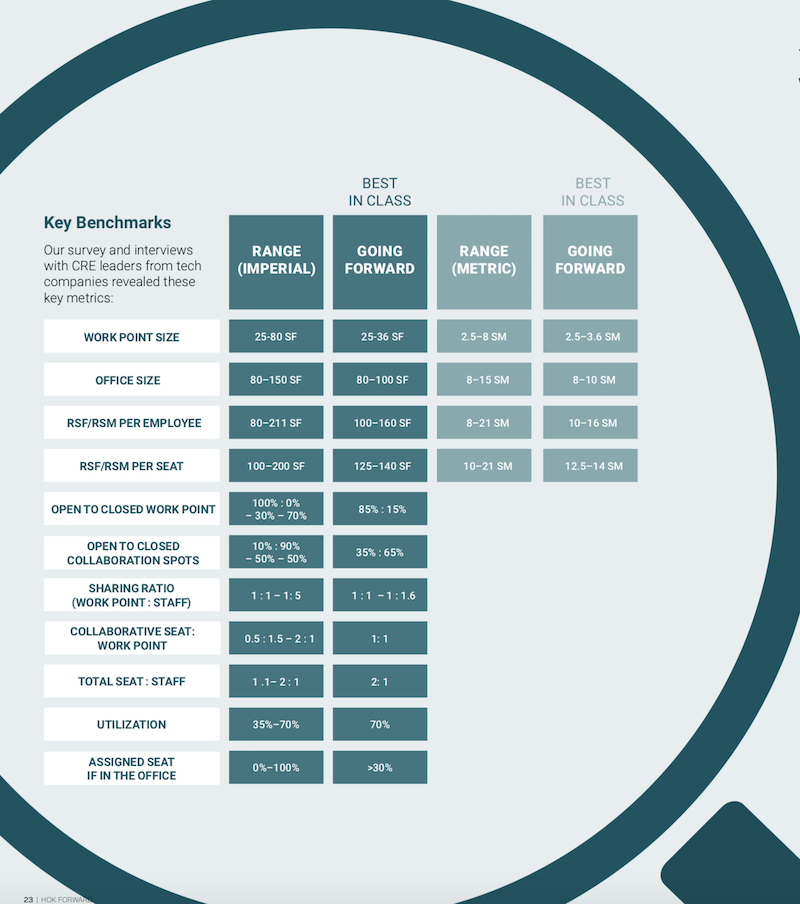
Some of the key office metrics, gleaned from interviews with leading tech companies. Image: HOK Forward report
“By focusing on human-centric metrics and thinking outside the box, we can create resilient tech workplaces that adapt to whatever the future may bring. We need to design this next- generation workspace with courage if we want to keep pace and truly transform the work experience.”
The report recommends 10 “focus areas” for growth-minded tech companies. They must create a “curated” workplace that emphasize innovation, amenities, and occupant wellbeing, which includes giving workers greater control over their work environments.
Companies should also be looking beyond sustainability—and toward net-zero energy and water, biophilia, and human health. They should also be using sensors more to gather data in order to track employee patterns and preferences.
HOK’s report advocates that companies rethink the suburban campus of the past and move toward a “new urban model” that emphasizes “blended, mixed-use environments that are revitalizing urban zones and catering to neo-urbanites.
The conundrum of this recommendation, however, is that building offices in urban centers is challenging and expensive. In addition, while the population migration to cities is “unprecedented,” a big portion of the middle class—“the bedrock of a city’s workforce,” acknowledges the report—continues to relocate to the suburbs, “posing additional challenges for urban locations that aspire to serve as thriving work centers.”
Related Stories
Biophilic Design | Oct 18, 2023
6 ways to integrate nature into the workplace
Integrating nature into the workplace is critical to the well-being of employees, teams and organizations. Yet despite its many benefits, incorporating nature in the built environment remains a challenge.
Office Buildings | Oct 16, 2023
The impact of office-to-residential conversion on downtown areas
Gensler's Duanne Render looks at the incentives that could bring more office-to-residential conversions to life.
Government Buildings | Oct 10, 2023
GSA names Elliot Doomes Public Buildings Service Commissioner
The U.S. General Services Administration (GSA) announced that the agency’s Public Buildings Service Commissioner Nina Albert will depart on Oct. 13 and that Elliot Doomes will succeed her.
Products and Materials | Sep 29, 2023
Top building products for September 2023
BD+C Editors break down 15 of the top building products this month, from smart light switches to glass wall systems.
Office Buildings | Sep 28, 2023
Structural engineering solutions for office-to-residential conversion
IMEG's Edwin Dean, Joe Gulden, and Doug Sweeney, share seven key focuses for structural engineers when planning office-to-residential conversions.
Mixed-Use | Sep 20, 2023
Tampa Bay Rays, Hines finalize deal for a stadium-anchored multiuse district in St. Petersburg, Fla.
The Tampa Bay Rays Major League Baseball team announced that it has reached an agreement with St. Petersburg and Pinellas County on a $6.5 billion, 86-acre mixed-use development that will include a new 30,000-seat ballpark and an array of office, housing, hotel, retail, and restaurant space totaling 8 million sf.
Giants 400 | Sep 18, 2023
Top 90 Office Building Engineering Firms for 2023
Jacobs, WSP, Alfa Tech, and AECOM head BD+C's ranking of the nation's largest office building sector engineering and engineering/architecture (EA) firms for 2023, as reported in Building Design+Construction's 2023 Giants 400 Report. Note: This ranking includes revenue for all office building work, including core and shell projects and workplace/interior fitouts.
Giants 400 | Sep 18, 2023
Top 120 Office Building Construction Firms for 2023
Turner Construction, STO Building Group, AECOM, and DPR Construction top BD+C's ranking of the nation's largest office building sector contractors and construction management (CM) firms for 2023, as reported in Building Design+Construction's 2023 Giants 400 Report. Note: This ranking includes revenue for all office building work, including core and shell projects and workplace/interior fitouts.
Giants 400 | Sep 18, 2023
Top 200 Office Building Architecture Firms for 2023
Gensler, Stantec, HOK, and Interior Architects top BD+C's ranking of the nation's largest office building sector architecture and architecture/engineering (AE) firms for 2023, as reported in Building Design+Construction's 2023 Giants 400 Report. Note: This ranking includes revenue for all office building work, including core and shell projects and workplace/interior fitouts.
Adaptive Reuse | Sep 15, 2023
Salt Lake City’s Frank E. Moss U.S. Courthouse will transform into a modern workplace for federal agencies
In downtown Salt Lake City, the Frank E. Moss U.S. Courthouse is being transformed into a modern workplace for about a dozen federal agencies. By providing offices for agencies previously housed elsewhere, the adaptive reuse project is expected to realize an annual savings for the federal government of up to $6 million in lease costs.


